![]()
![]()
![]()
Use LEFT and RIGHT arrow keys to navigate between flashcards;
Use UP and DOWN arrow keys to flip the card;
H to show hint;
A reads text to speech;
107 Cards in this Set
- Front
- Back
|
Define generally the client , consultant and contractor . |
-The client determines the nature of the project and provides the funds -The consultant conceptualizes the project -The Contractor brings it to being |
|
|
What are the Roles of a Consulting Engineer? |
-To act as an advisor to client or architect -To design according to the requirements of the client or architect - To suggest rational modification - Detail and produce working drawings - Supervise contractor during construction
|
|
|
Define the critical path ? |
This can be defined as the longest possible path through the network of project activities. |
|
|
What is a Constraint ? What is a resource Constraint ? |
A Constraint is simply a restriction on the options available. A resource Constraint is the constraint that arises from the unavailability of some resource of equipment, material, space or labor. |
|
|
What are the steps to be followed when producing a network ? |
- Listing the operations - Producing a network showing logical relationship between the activities - Assessing duration of each activity - Producing a schedule - Determining start and finish times - Determining the Float available - Assessing the resources |
|
|
What is a dummy activity ? |
A dummy activity is an activity that is assumed to have no time duration . ( Graphically represented by a dashed line in a network ) |
|
|
What is the rule for calculating the forward pass and back pass? |
-When you're going forward, you add. And pick the largest sum . -When going backwards , subtract and pick the smallest difference . |
|
|
What are critical activities ? |
-These are activities with no float - Activities whose earliest Start and latest start are essentially the same . |
|
|
What is total Float ? |
This is maximum delay which can be assigned to any activity without delaying the entire project. |
|
|
What's the formula for total Float ? |
TF (I,j)= L(j) - E(i) - D(ij) |
|
|
What is free float ? |
This is the amount of delay that can be assigned to any one activity without delaying subsequent activities. |
|
|
What is the formula for Free float |
FF (I,j)= E(j) - E(i) - D(i,j) |
|
|
Define independent float ? |
This is the amount of delay which can be assigned to one activity without restricting the scheduling of preceding activities. |
|
|
What is the formula for independent float ? |
It's Either 0 or IF(i,j)= E(j) -L(i) - D(ij) |
|
|
What is interfering Float ? |
This is the difference between total Float and free float . Unofficially going by the formula IntF (i,j) = L(j)- E(j) |
|
|
What are the 13 parameters for the line of balance method and their symbols? |
- Total number of person hours (M) - Target Rate of build (U) - Hours per week (H) - hours worked per day (h) - # of working days per week (d) - Buffer time (B) - Optimum Gang size (Q) - Theoretical gang size (G) - Total number of things (n) - Time per operation ( T ) - Natural rate of build ( U ) - Elapsed time ( S ) - Actual gang size (g) |
|
|
What is the formula for Theoretical gang size ? |
G = R x M / H |
|
|
The line of balance table only has 8 parameters. List then sequentially. |
- Operation - M ( Person hours ) - G ( Theoretical gang size ) - Q ( Optimum Gang size ) - g ( to nearest multiple of Q) - U ( Natural rate of build ) - T ( Time per Operation ) - S ( Elapsed time between start of first unit and stat of last unit ) |
|
|
Whats the formula for natural rate of build ? U |
U = (g x R ) / G |
|
|
What is the formula for Time of Operation ( T ) |
T = (M/h) x (1/Q) |
|
|
What is the formula for Elapsed time ( S ) ? |
S =[ ( n-1 ) x d ] / U |
|
|
What's the rule for moving from one event to the other using the Line of Balance technique ? |
If moving to an event with higher S . Add the buffer time at the bottom. And when moving to an event with lower S . Add the buffer time at the top. |
|
|
Other than Price , What Serious considerations from past performance should be taken into consideration when selecting a contractor? |
- Competence and experience - Quality of materials used and Finishes - Ability to comply with construction programs |
|
|
On tender basis , Selection of contractor to undertake work should be examined in the light of factors such as: |
- Management and Equipment Capacity - Basis of Labour Rates - Prices and Overheads |
|
|
What is the difference between the sequential and accelerated procurement method ? |
In the sequential model , the contractor receives all the details . In the Accelerated model the contractor receives only part of the design |
|
|
What is the design and build model ? |
This is where the employer makes his requirements known to on me organization which both designs and carries out the work. |
|
|
What is the main advantage of the design and build model ? |
It results in a design which is better suited to the contractors construction method. Lowering production cost and shorter contact period |
|
|
What is the difference between Management Contracting and Construction Management Contracting ? |
- in Management Contracting, the Subcontractors have no contractual relationship with the client . They do however have a contractual relationship with the Managing Contractor. - In Construction Management Contracting , the client does have a contractual relationship with everyone including the Subcontractors. - the Construction manager ( not managing Contractor ) has a functional control relationship with the sub contractors. |
|
|
Project Costs may be divided into the following items ? |
- Material costs - Labour costs - Tools and equipment - Overhead and Supervision - Profit |
|
|
The consultant should be equipped with latest information on : |
- New Materials - New Construction Equipment - New Methods of Construction |
|
|
How can a consultant engineer reduce the cost of construction? |
- Design multiple Similar members - Simplify design where possible - Use local materials when they are satifactory - Write simple straight forward specifications - Use standard specs |
|
|
How can contractors reduce cost on a project ? |
-Pre - bidding studies of the project and the site. - holding conferences with key personnel to discuss plans , procedures and results. - Adoption of safe practises to reduce cost . - Sub - Contracting specialists who can do the work better. - improving workshop and servicing facilities for better maintenance of construction equipment. |
|
|
What is Capital ? |
Capital refers to wealth in the form of money or property that can be used to produce more wealth. |
|
|
What is the formula for Simple interest? |
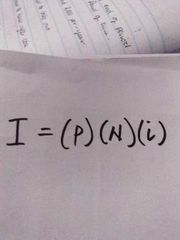
|
|
|
What formula can you use to find the present amount P, that can grow into a future amount,F, in N periods at a compound interest i . |
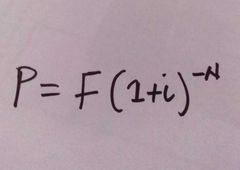
|
|
|
What is the formula for finding Future amount given P, i and N. |
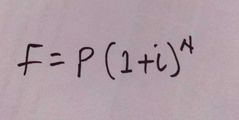
|
|
|
What is the formula for finding Future amount F given end of period cash flow A , I and N . |
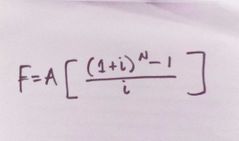
|
|
|
What is the formula for finding present amount A given end of period cash flow A, I and N. |

|
|
|
Formula for finding how much you need to invest each year A to get a future amount F given I and N. |
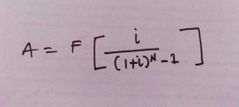
|
|
|
Formula for finding out how much you can remove each year(A) if you invested an initial amount (P) , given I and N |
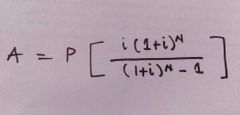
|
|
|
What is construction planning generally concerned with ? |
Construction planning is generally concerned with completing a contract in the shortest possible time, within budget and according to specifications |
|
|
What is management ? |
It is the art of physically making the plan work. |
|
|
What 3 things should planning achieve? |
- Give the client intended completion or hand over dates - Notify Suppliers and Subcontractors when their goods and services will be required - Give contractor knowledge of future commitments to staff, labour and plant |
|
|
Mention 3 things that should be done before site operations . |
- Proper planning of equipment and methods - Ordering of materials - Preparation of a balanced programme. |
|
|
List 5 advantages of planning ? |
- Planning shows possible problems in advance and thus provides opportunities for their avoidance - Planning increases productivity by reducing double handling - It leads to faster and more efficient construction .Which reduces the total cost (less on-cost and lower overheads) - Planning provides a useful basis for ordering material and a comparative reference for assessing progress. |
|
|
Mention 4 things that should be done before preparing a construction schedule.? |
- A project should be divided into desirable operations. - The amount of work in each operation should be determined. - The rate of performing work should be estimated for each operation. - An appropriate allowance should be made for loss of time due to bad weather. |
|
|
What are the two basic possibilities of utilising available resources? |
- Resource Levelling - Resource Smoothing |
|
|
What is the difference between resource levelling and resource smoothing? |
In resource levelling, the available resources (crew) are fixed right from the beginning to the end. In resource smoothing, there is variation in the resources used but the variation is not large. |
|
|
What is the difference between a time-constrained project and a resource-constrained project. |
A time constrained project is one that has to be completed by imposed date. A resource constrained project is a project where the number of available resources can not be exceeded. |
|
|
An Architect or Engineer commissioned by a client to design a structuremust develop three basic documents which the contractor must usewhen he undertakes to construct the structure. These documents are:
|
-The drawings -The conditions of the contract -The specifications |
|
|
-Contract documents consist of the following? |
-Agreement , a written agreement between the owner andcontractor setting forth;the work to be performed.the time for completion.the contract sum. -Conditions of the Contract: These consist of the general conditions, supplementary conditions and otherlegally binding conditions. -Drawings : The graphic presentation of work to be done -Specifications : Written description of work to be performed. |
|
|
What are bidding documents ? |
This is a term generally used to describe the documents furnished to bidders. Theyinclude not only the contract documents, but also the bidding requirements. |
|
|
-What are specifications ? |
Specifications are a written description of work to be done, forming partof the contract and describing qualities of materials and mode of construction, andalso giving dimensions and other information not shown in the drawings. |
|
|
Specifications are used by a diverse group of parties name them. |
-The contractor to tell him about quality and workmanship required. -The estimator in the contractors office, who prepares the estimate based on thespecifications. -The purchasing agent in the contractor’s office who procures the materials andequipment described in the specifications. -The Resident Engineer, who must be given a document that can aid him ininspecting and controlling the work. -The owner, who would like to know what he is buying and what he is entitled toreceive . -the subcontractors so that each can know the scope of his subcontract. -the manufacturer of building materials and equipment so that the grade and typeare clearly defined with respect to the many variations they may manufacture |
|
|
-Bidding requirements include |
-The invitation to Bid
-Instructions to Bidders -The Bid form. -The Bid Bond. |
|
|
List down the information that drawings are supposed to have? |
-Extent, size, shape and location of components. -Location of materials, equipment and fixtures.
-Detail and overall dimensionsInterrelation of materials, equipment and space. -Sizes of equipmentSchedules of finishes, windows and doorsIdentification of class of material at its locationAlternates.. |
|
|
-List down the information that specifications are supposed to have? |
-Type and quality of materials, equipment andfixturesQuality of workmanship. -Methods of fabrication. installation and erection. -Test and code requirements.
-Gauges of manufacturers’ equipment. -Allowances and unit prices.
-Alternates and options. |
|
|
-What are the four types of specifications? |
.Descriptive
.Performance .Proprietary .Reference |
|
|
What are descriptive specifications and give an example? |
These can be defined as describing in detail, the materials to be used and workmanshiprequired to fabricate, erect and install the materials. |
|
|
-Give examples of descriptive specifications ? |
An example would be
-The brick and mortal ingredients -Composition of the mortar tests of individual components. -Weather conditions during erection. -Workmanship involved in laying up the brick -Type of brick bond, jointing and finally the cleaning procedures. |
|
|
What are performance specifications ? give some examples |
- Performance specifications can be defined as specifying an end result by formulating thecriteria for its accomplishment.
As an example, in a performance specification for a paint material, the end result is obtainedby formulating or specifying the following criteria: The painted surface shall withstand 10 washings with a mild detergent. The paints surface shall show no sign of alligatoring or cracking.The painted surface shall have an eggshell finish |
|
|
What are reference specifications ? give some examples |
-These specifications refer to a standard established for either a material, a test method or aninstallation procedure. These standards are predicated on either descriptive or performancecriteria. example : The specifier now simply states that Portland cement must “meet the requirements of BS 118”.By making reference to a standard, the standard becomes a part of the specification in thesame way as descriptive or performance specification language is used.It is essential that the architect & specifier is thorough familiar with the standards incorporated |
|
|
-What is an example of a proprietary specification? |
-This is one in which the specifier states outright, the actual make, model, catalogue numberand so on of a product or the installation instructions of a manufacturer |
|
|
-Under specification writing techniques ,what does work of other sections mean ? give an example |
This heading should be reserved to exclude from a section those items a contractor heading should be reserved to exclude from a section those items a contractormight normally expect to find under a specific section, but which the specifier for hisown good reasons elects to specify under another section.
|
|
|
-Under Specification writing techniques, what are grand father clauses and give an example. |
These are clauses which embrace everything, yet fail to be specific. Example -“The constructor shall furnish and include everything necessary for the full and complete constructionof the building whether shown or specified or not shown or described.” |
|
|
-What is residual legatee under specification writing and give examples. |
In applying this principle to specifications writing, the materials occurring in the smallestquantity or in the fewest places should be listed first, and the material occurring in theremaining places becomes the residuary legatee and can be covered by such a phrase as“the rest of the building"
|
|
|
-Specifications should avoid duplication and should be written in an imperative mood. Briefly explain what this means. |
-Duplication: A steel ladder might be detailed on a drawing, giving the size of the members and spacing of the A steel ladder might be detailed on a drawing, giving the size of the members and spacing of therungs. The specification should, itself, describe the quality of the material and how the rungs are let intothe side members, and should not repeat the sizes and spacing since the drawing may be altered bythe draftsman, with a resulting conflict in the two documents. Imperative mood: Specifications are written instructions to a contractor to perform work under acontract. Therefore he needs instructions that are clear and unencumbered bysuperfluous language. the contractor shall. |
|
|
-What information does the invitation to bid give the prospective bidder? |
-Whether the work is in his line. -Whether it is within his capacity -Whether he will have the time to prepare a bid prior to opening. |
|
|
-What elements are contained in the invitation to bidders. |
-Project Title -Identification of principles -Time and place of reciept of bids -Project description -bid security -guarantee bonds -type of contract -Examination and Procurement of Documents |
|
|
What are the elements of the instructions to bidders. |
The Instructions to Bidders consist of the following elements:
- Form of Bid : Identify the form of bid and indicate the number of copies to be submitted. -Preparation of Bid : Describe which blank spaces in the Bid Form are to be filled in by the bidder, including base bids, alternatives,unit prices, and so on. -Withdrawal & Modification of Bids : State how bids can be withdrawn or modified prior to bid opening. -Award of Contract : Describe the procedure under which the award of the contract will be made -Rejection of Bids : State the conditions under which the bids can be rejected. -Other Instructions to Bidders; State whether certain information relative to financial status, subcontractors. andsubstitutions are to be submitted with the Bid Form |
|
|
-What is a surety bond ? |
Surety Bonds make it possible for the Contractor to assure the Owner that the Project will becompleted in accordance with the Contract Documents including payment of all obligations.
|
|
|
-What is a warranty in a construction project. |
-A Warranty is sometimes required in a construction contract in connection with the furnishingof certain materials, products, or equipment. By means of the warranty, the contractor ormanufacturer certifies that the material, product or equipment will perform as required.
-A warranty promises performance, and if the warranty is not as stated and if the material,.product, or equipment should fail to perform as warranted, the contractor or manufacturerhas committed a breach of contract, and the owner may seek legal recourse for fulfilment ofthe warranty. |
|
|
There are a number of standard forms of contract used in Civil Engineering and building. Themost commonly used are indicated below: |
-Institution of Civil Engineers’ New Engineering Contracts (NEC) : It is applicable to all Civil Engineering construction works.It is particularly suitable for general Civil Engineering work which is predominantly either in theground or in, or adjacent to water, and caters for the attendant risks and claim situations.It is also sometimes used for building works and for mechanical and electrical works where suchworks are included in a Civil Engineering or building contract. -fidic -General Conditions of Government Contracts forBuilding and Civil Engineering Contracts(GC/Works/) : This form of conditions is suitable for both Civil Engineering and building works as the title form of conditions is suitable for both Civil Engineering and building works as the titleindicates.Unlike most other standard forms, it is not produced by a joint body representing various most other standard forms, but solely by the employing agency.It is fairly a versatile document which can be used with either drawings, specifications, bills of quantities and/or schedule of rates. JCT Standard Form of BuildingContract- This is the building equivalent of the ICE conditions.It is probably the most commonly used for all the standard forms and is issued by the Joint.Contracts Tribunal representing the Royal Institute of British Architects, the Building Employer’sConfederation, the Royal Institution of Chartered Surveyors, the Country Councils Associationand five other associations.This form has six versions. |
|
|
-In terms of construction safety, what are direct losses. |
-Direct losses can be measured in monetary terms. These are losses to the employer, which he.pays to the worker for compensation. The employer also pays for medical expenses incurredon the worker. |
|
|
-What are indirect losses and give some examples? |
Indirect losses cannot be measured directly in monetary terms and arise from the followingsources:
-Loss of time of the injured person. -Loss of time of his fellow workers, who stop work at the time of the accident to help him or to showsympathy or for curiosity. -Loss of time of supervisors in assisting injured worker and in investigating and preparing a report of the accident and in making alternative replacement arrangements -Loss due to damage caused to any equipment. -Loss due to reduction in efficiency of the worker when he returns after recovery. -Loss due to reduction in the efficiency of fellow workers due to fall in their morale. -Loss to the injured worker. Injured worker suffers the following losses:loss to his incomeloss due to medical expenditurepain felt by the worker, which cannot be compensated. |
|
|
-What are the different ways people can fall and how can you prevent this. |
-Persons falling People can fall in many ways from scaffolds . from ladders . from structures . from plant . into excavations . into manholes . on the level .
Key factors in reducing the number of falls are:site tidiness.adequate scaffolds and ladders.barriers around excavations and holes. |
|
|
-How can materials fall on site and how can you prevent that? |
-From a height to the ground
-From the ground into excavations -On the level |
|
|
-How can injury come from plant machinery and transport? |
Risks arise in the operation of any plant, lifting gear or lifting appliance and these areaffected by the intervals between inspections.
-Injuries arise from a variety of causes: machinery striking people -collisions between machines. -machinery overturning. |
|
|
-Mention some of the miscellaneous accidents on site |
stepping on objectsstriking against objects.electric shock.particles in eyes.collapse of excavations.strains and twists.burns and scalds.
|
|
|
-How can miscellaneous accidents be prevented? |
-keeping the site tidyguarding hazardous objects. -Effective electrical earthing.wearing protective clothing.
-Fitting appropriate guards. -supporting excavations. -correct lifting and carrying. -safe working practices with hot or flammable materials. |
|
|
-Mention the five types of insurance |
Employer’s Liability Insurance -covers employees if they are injured or suffer health problems as a result of employment. -it protects the employer against claims from employees for bodily injury or disease arising out of the course ofemployment. Public Liability Insurance. -covers contractors against claims from the general public for bodily injury or disease. Damage to property ofgeneral public can be included. Contractor’s all risks insurance -This covers loss or damage to: all permanent and temporary works -plant, equipment and temporary buildings -employees’ personal effects if not already insured elsewhere. -Hired plant may also be included. -Plant and Equipment insurance.This is usually included in Contractor’s all risk. A plant hire company will have its plant insured. -Engineering insurance This covers accidental breakdown/damage to lifting machinery, electrical and mechanical plant. It may becovered in Contractor’s all riskCEE |
|
|
What are some of the advantages of using equipment on site. |
tough work which is beyond the scope of manual labour can be performed efficientlyand speedily. -When manual labour is uncertain (work stoppages) m/ cs are the only alternatives;further, equipment is not affected by social economic conditions of a region. -with use of m/ cs , proper planning of work can be done which consequently reducesthe overall cost of the project. -On large projects or when large quantities of materials are to be transported from oneplace to another, use of equipment is always cheaper. |
|
|
Some of the general factors to be considered in the selection of construction equipment are:
|
-Ease of procurement : If there is a wide choice, relatively easily acquired equipment should be given higher consideration.
-Standardization : If possible, choice should be restricted to standard equipment. Special equipment should be selected only if thejob justifies its selection. Equipment Variety : Choice should be limited to less variety of equipment. Many varieties mean more skilled workers, more spareparts requirements and increased project cost. Obsolescence : In terms of spare parts and salvage value avoid procuring equipment out of production. Versatility : If possible equipment should be capable of performing more than one function. Technical and economic aspects : These should be carefully analysed before the decision to buy is made. Costs, work capacity, etc. |
|
|
Equipment costs can be classified into two groups. Name them. |
-Operating costs -Ownership costs |
|
|
-What are ownership costs of equipment and give some examples. |
Ownership costs:These are costs incurred for owning equipment whether the equipment is in use or not.
-Capital cost of the plant (interest on capital) 1.Equipment is often bought through a loan. The interest payments are a cost. -Even when the equipment is bought using own capital, a cost equivalent to interest chargeshould be allowed since the money could earn interest in a bank if not used to buyplant. -DepreciationThis is the loss of value resulting from usage or age. A contractor normally recovers this loss by including a sum of money equivalent to the depreciation cost in his rates fordoing work or hiring out the plant. |
|
|
What are operating costs of equipment and give some examples. |
Operating costs:
1.Running and repair costs : Running costs include cost of fuel and lubricants. -Repair costs arise from maintenance. -These costs vary for different types of equipment, conditions of work and hoursworked. Experience and records are the only ways of estimating such costs. They areusually allowed for as a percentage of the initial cost. 2. Licence and insurance cost:Licences are a small charge when equipment is not used on public roads but become.a considerable expense otherwise. Lifting appliances such as cranes have to beinspected by an insurance company, which adds an additional cost.Amount and type of insurance depends on whether the equipment is to use public.roads or not. For equipment which will not use pubic roads, the premium is quite smalland may only cover fire and theft. Equipment using public roads will have to becovered by the minimum legal requirements just like other road users 3.Overheads (or establishment charge) -An allowance for all the normal equipment administration. |
|
|
Mention 2 methods of depreciation ? |
-Straight line method -Declining balance method |
|
|
-Name the 3 types of construction equipment ? |
-Concrete equipment. -Earthwork equipment. -Earth Compacting equipment. |
|
|
When selecting of a contractor Other than price equally serious considerations from pastperformance should be: |
• competence and experience
• quality of materials used and finishes • ability to comply with construction programmes |
|
|
On tender basis, selection of contractor to undertake workshould be examined in the light of such factors as: |
• management and equipment capacity.
• basis of labour rates • prices and overheads. |
|
|
|
|
|
|
|
|
|
|
|
|
|
|
|
|
|
|
|
|
|
|
|
|
|
|
|
|
|
|
|
|
|
|
|
|
|
|
|
|
|
|
|
|
|
|
|
|
|
|
|
|
|
|
|
|
|
|
|
|
|
|
|
|
|
|
|
|

